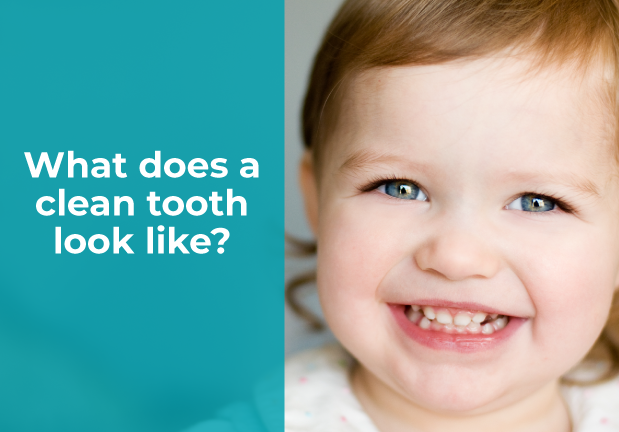It's a New Day in Public Health.
The Florida Department of Health works to protect, promote, and improve the health of all people in Florida through integrated state, county, and community efforts.
Toddlers (age 1-4)
 Caring for your child’s teeth early prevents issues like cavities (tooth decay) and gum irritation, setting the foundation for a lifetime of good health.
Caring for your child’s teeth early prevents issues like cavities (tooth decay) and gum irritation, setting the foundation for a lifetime of good health.
Healthy teeth are essential for your child to eat, speak, and grow properly. Focusing on good oral health and healthy habits early on helps children grow into healthy adults.
Daily Oral Care
- Brushing Teeth: Brush twice a day with a smear layer of toothpaste (equal to a grain of rice) for children ages 1 to 3 and a pea sized amount of toothpaste for older children. Brush after breakfast and last feeding of the night, with a small, soft toothbrush once your child's teeth grow in.
- Spitting Out Toothpaste: Ensure your child spits out the toothpaste or wipe the toothpaste out with a clean washcloth.
- Flossing: Begin flossing your child's teeth once a day when teeth start touching each other.
Engage in Oral Health Habits as a Family
Set a great example by practicing good oral hygiene with members of the family. Encourage:
- Brushing teeth twice a day with toothpaste and a soft toothbrush
- Flossing daily before bedtime
- Choosing water and healthy food items and limiting sugary food items and drinks
- Visiting a dental professional regularly for cleanings and care

Keep Teeth Clean
A clean tooth will look shiny.
Plaque makes the tooth appear dull. Plaque may be clear, white or colored from food items and drinks.
To keep healthy teeth, plaque must be removed every day.
Resources
The Florida Department of Health operates dental programs through the Women, Infants, and Children (WIC) Program, Early Head Start, and Head Start programs in most counties. These programs provide services including dental screenings, topical fluoride application, and oral health education.
Contact your local county health department for services and more information and program eligibility.
- Teething
- Dental Health Visits
- Toothbrushing and Flossing
- Healthy Eating Habits
- Importance of Vitamin D
- Protecting Your Child from Germs
- Safety Hazards
Children may get front teeth as late as 12 months of age. The back molars usually come in between one and two years of age. Contact a dental professional if you have questions or concerns.
Teething Symptoms
- Drooling
- Fussiness or irritability
- Trouble sleeping
- Slightly raised temperature (under100.4° F*)
- Loss of appetite
*Contact your health care provider if your baby has a fever higher than 100.4° F or is vomiting, has diarrhea, or has a rash.
How to Soothe Teething Pain
- Provide your baby with clean and cool, firm teething rings or pacifiers (not frozen)
- Use a clean, cold washcloth to gently massage your baby’s gums
- Provide cool, soft foods like yogurt or applesauce
Your baby should never chew on items that have small pieces, could be broken, or are electrical.
First Visit
Visit a dental professional by your baby’s first birthday. Your dental professional will:
- Check your baby’s mouth for healthy development
- Provide personalized advice on how to care for your baby’s teeth
- Your dental professional may offer topical fluoride to help prevent tooth decay or cavities.
Maintaining Regular Dental Visits
Visit a dental professional at least once per year or more often as recommended.
Contact a dental professional if you have questions or notice anything unusual.
When Teeth Appear: Switch to a small, soft toothbrush when your child’s first tooth emerges. Use toothpaste when brushing.
Brush Twice a Day: Brush your child’s teeth twice a day, after breakfast and before bedtime to help prevent tooth decay and gum disease.
Amount of Toothpaste to Use
- Smear layer (equal to a grain of rice), for children ages 1-3
- Use a pea-sized amount, for children ages 3+
Spitting out Toothpaste: Teach your child to spit out the toothpaste rather than swallow it. If they struggle with spitting, gently wipe excess toothpaste from their mouth with a clean washcloth.
Helping with Toothbrushing: Children may like brushing their own teeth, but they need help until they are 7-8 years old. Try letting your child brush first and follow up by brushing their teeth again, if needed.
Flossing: Begin flossing your child's teeth once a day when teeth start touching each other. Floss in between each tooth that touches another tooth. Gently glide the floss between the teeth and create a C shape with the floss to hug the tooth without injuring the gum. Raise the floss up slightly and form the C shape for the other tooth that touches.
Transitioning from a Bottle to a Cup: Encourage your child to transition from a bottle to a cup around age 12-14 months. This will help ensure proper jaw development.
Healthy Food Options: Provide your child with nutritious options like fruits, vegetables, whole-grain products, dairy products, lean meats, fish, eggs, and beans.
Limit Sugary Drinks and Food Items: Sugary drinks and food items can lead to cavities (tooth decay).
- Provide children with healthier alternatives, like fruit instead of juice. Limit juice intake to four ounces per day for children ages 1-6.
- Offer water several times a day once introduced.
- Avoid putting your child to bed with a bottle or cup of milk, juice, or sugary drinks.
- Avoid dipping pacifiers in any sweet food items or drinks.
- Limit sweets like cookies, crackers, candy, gummies, dried fruits, ice cream, and cake.
Hydration and Dry Mouth Prevention: Some conditions and medications can cause dry mouth, increasing the risk of cavities (tooth decay). Ensure your child drinks plenty of water throughout the day.
Safety: Cut, grind, or mash hard-to-chew foods. Feed your child in an upright position and always monitor when feeding to prevent choking.
Vitamin D supports bones and healthy teeth, by helping the body absorb and keep enough calcium and phosphorus. Vitamin D also plays a role in the immune system.
Low levels of vitamin D in children are associated with higher cavity rates.
Toddlers, older children, and adolescents need 600 IU of vitamin D each day.
Getting Enough Vitamin D
Supplements
- All non-breastfed infants, as well as older children, who are consuming less than 32 ounces per day of vitamin D-fortified formula, should receive a vitamin D supplement of 400 IU a day.
- Children with an increased risk of vitamin D deficiency, such as those taking certain medications and with chronic diseases, such as cystic fibrosis, may need higher doses of vitamin D. Consult your pediatrician.
Your child’s skin characteristics can affect the vitamin D that their body makes. In particular, the pigment in your child’s skin is an important factor to consider; darker skinned people manufacture less vitamin D than those whose skin is lighter.
Natural Sources
Food that contains vitamin D include salmon, sardines, tuna, mackerel, shitake mushrooms, and hard boiled eggs.
Enriched foods are another way to increase the vitamin D in your child's diet. Look for foods fortified with vitamin D such as milk, cereal, orange juice, and yogurt.
Vitamin D is also made by your child’s body with the sun’s ultraviolet rays. When your child is exposed to sunlight, it helps his body synthesize vitamin D in the skin. And it doesn’t take much time in the sun to produce adequate amounts of vitamin D.
However, not all children get enough sunlight, particularly during certain times of the year or in northern regions of the U.S. Dense cloud covers and high levels of air pollution can reduce the ultraviolet rays reaching the skin.
Clean Pacifiers and Teething Rings: Wash daily with soap and water, and sterilize regularly, especially when dropped on the floor.
Avoid Spreading Germs: Don’t clean pacifiers with your mouth as this can spread bacteria that can cause cavities (tooth decay). For the same reason, use a separate spoon to taste your child’s food, whenever possible.
Protect your child’s growing smile by avoiding hazards:
- Keep your child from chewing on items like remote controls, electrical cords, items with small pieces, sharp objects (e.g., table corners and metal edges), and other items that may break in their mouths, shock, or burn them.
- Always supervise meals to prevent choking.
See a dental professional as soon as possible if your child injures a tooth or has a severe injury to their gums, lips, or jaws.



Connect with DOH